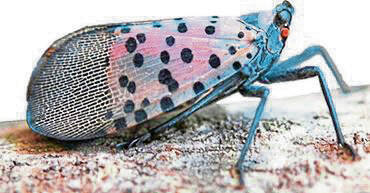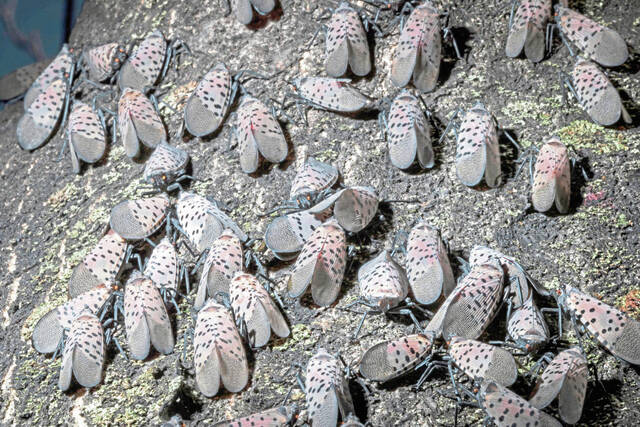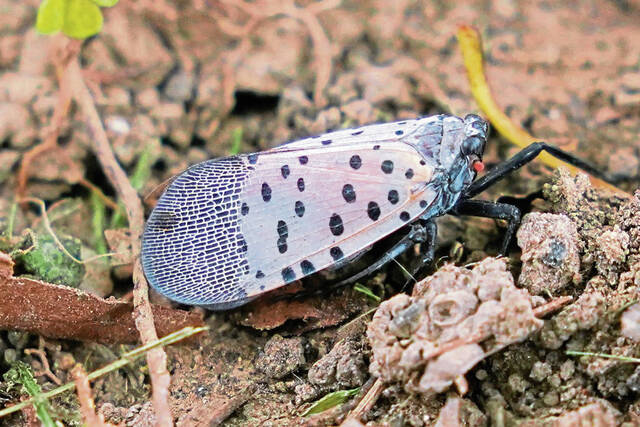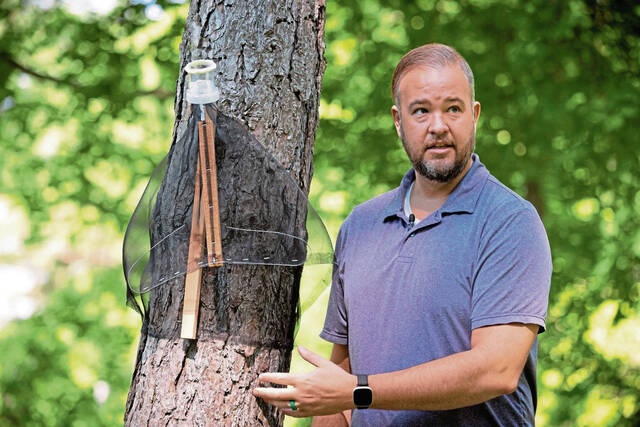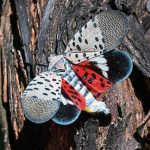The best kind of spotted lanternfly is a dead spotted lanternfly, agricultural experts say.
The spotted lanternfly is an invasive insect that has spread throughout Pennsylvania and other states. While the bug poses no threat to people, it is a danger to trees and other flora. Spotted lanternflies cause damage by sucking sap, and the waste product of their diet can cause fungal disease. Vineyards and Ailanthus altissima, commonly known as tree of heaven, are favorite targets.
“They’re mostly a nuisance insect,” said Sandy Feather, an educator with the Penn State Extension in Pittsburgh.
The invasive insect has spread throughout the state since its discovery in 2014 in Berks County. Researchers say the insect threatens the state’s grape, tree fruit, hardwood and nursery industries. If containment fails, spotted lanternflies could drain the state’s economy of at least $324 million annually and cause the loss of about 2,800 jobs, according to Penn State’s College of Agricultural Sciences.
Researchers are expecting the number of spotted lanternflies to increase this year, Feather said.
By the numbers
With the warmer weather, laternflies should begin hatching in the next couple of weeks. There already have been a few reports in the southeast corner of Pennsylvania, said state Department of Agriculture spokeswoman Shannon Powers. On May 9, the department received and confirmed reports of lanternflies hatching in Harrisburg.
As of Wednesday, there has been only one confirmed report of hatching from Allegheny County and one in Westmoreland County, Powers said.
To stop their spread, people should scrape the egg masses and stomp on the adult pests when they see them.
Powers said killing one spotted lanternfly prevents 30 to 60 insects from hatching next year.
It’s past the point of totally eradicating the pests, Feather said, but people can take steps to stop their spread. She said property owners can reduce infestations by using a “circle trap,” a funnel-type device that wraps around a tree trunk. Circle traps guide spotted lanternflies into a container, such as a plastic jug or bag, at the top of the funnel as they move upward to feed on the tree.
Powers said in 2022, there were 4,512 public reports of spotted lanternflies in Allegheny County, compared to 24,595 in 2021. In Westmoreland County, there were 161 public reports of spotted lanternflies in 2022, and 1,932 in 2021.
Statewide, there were 42,440 reports of the insects in 2022, and 55,681 in 2021. Powers noted reports are not always accurate, and they are not a count of lanternfly infestations but rather a measure of public awareness and willingness to report.
She also said people were largely confined to their homes in 2021 because of the pandemic and had more free time to search for lanternflies and report them.
Hitchhikers and plant hoppers
Allegheny, Armstrong and Westmoreland counties already are classified by the state Department of Agriculture as being in a spotted lanternfly quarantine. Butler County and five other counties were added to the list in February. Those additions mean 51 of Pennsylvania’s 67 counties are in quarantine.
“We expand the quarantine based on confirmed populations, so that’s why it’s important to report them,” Powers said.
Quarantines aim to stop the spread of the spotted lanternfly to new areas within or outside of the current quarantine, according to state authorities. Businesses that operate in, or travel through, counties under quarantine are required to obtain a permit.
According to the state, the quarantine prohibits the movement of spotted lanternflies, and it regulates movements of items such as firewood, tree parts, nursery stock, landscaping or construction waste — things that spotted lanternflies can cling to for transportation.
In Allegheny County, spotted lanternflies commonly are found near the North Shore, in Downtown Pittsburgh, at Kennywood and the river trail along the Allegheny River, Feather said. She called the pests “hitchhikers,” as they can cling on people’s clothing and their vehicles.
“They really travel along main travel corridors,” Feather said, such as railroads, highways and barges.
People can report a spotted lanternfly sighting by visiting the Penn State Extension’s website or by calling 1-888-4BADFLY.




